| Article ID | Journal | Published Year | Pages | File Type |
|---|---|---|---|---|
| 1920604 | Parkinsonism & Related Disorders | 2014 | 5 Pages |
SummaryMany pharmacological agents may induce a variety of movement disorders, including dystonia, tremor, parkinsonism, myoclonus and dyskinesia, with an acute, subacute or more chronic time course. Motor symptoms may be isolated or part of a more extensive cerebral or systemic condition, such as the neuroleptic malignant syndrome or the serotonin syndrome. Drug-induced movement disorders share a number of features that should make them easy to identify, including a clear temporal relationship between medication initiation and symptom onset, a dose-effect, and, with the exception of tardive syndromes, complete resolution after discontinuation of the offending agent. Diagnosis relies on a thorough medication history. Medications commonly involved include dopamine receptor blockers, antidepressants and anti-epileptics, among many others. Mechanisms underlying drug-induced movement disorders involve blockade, facilitation or imbalance of dopamine, serotonin, noradrenaline and cholinergic neurotransmission in the basal ganglia. The present review focuses on drug-induced movement disorders that typically develop as an acute (hours to days) or subacute (days to weeks) event, including acute dystonic reactions, akathisia, drug-induced parkinsonism, neuroleptic malignant syndrome, serotonin syndrome, parkinsonism-hyperpyrexia syndrome, drug-induced tremor, drug-induced hyperkinesias and movement disorders associated with the use of recreational drugs.
